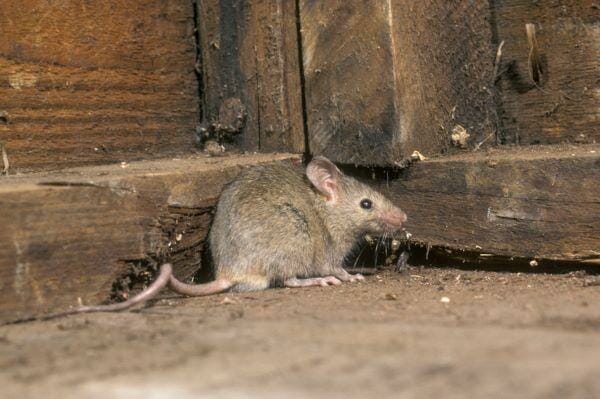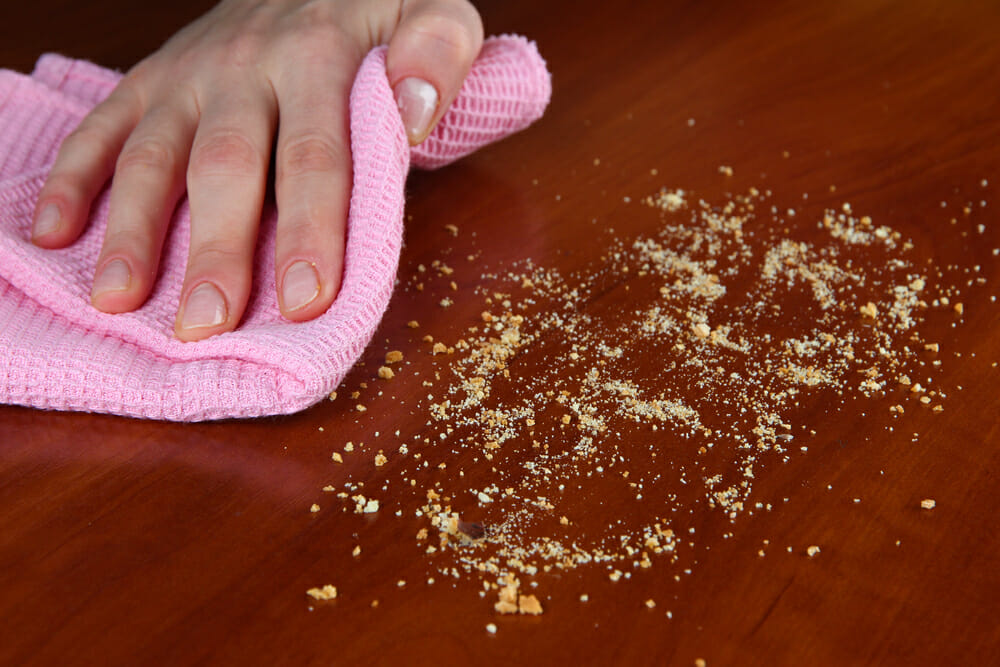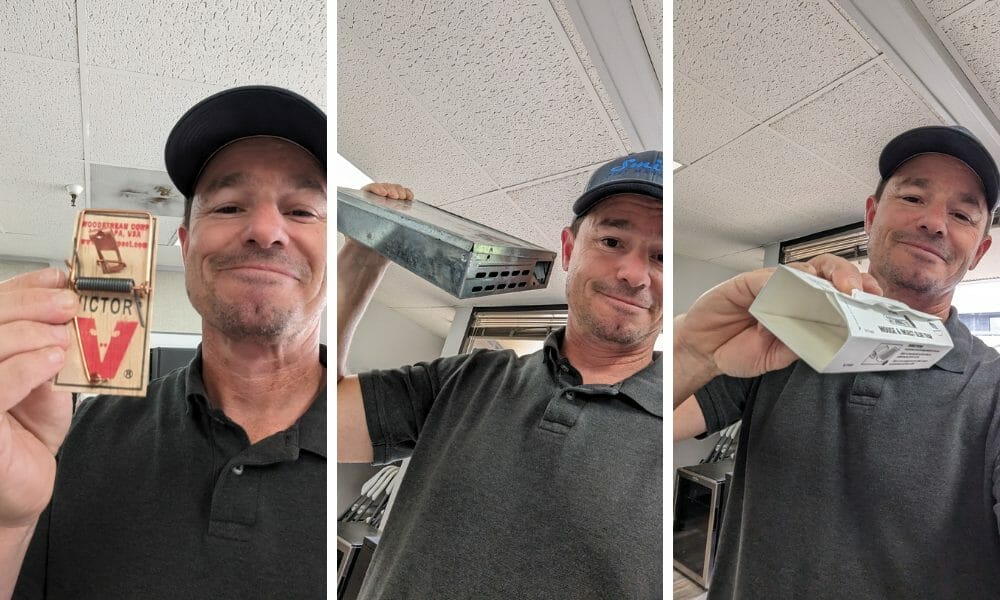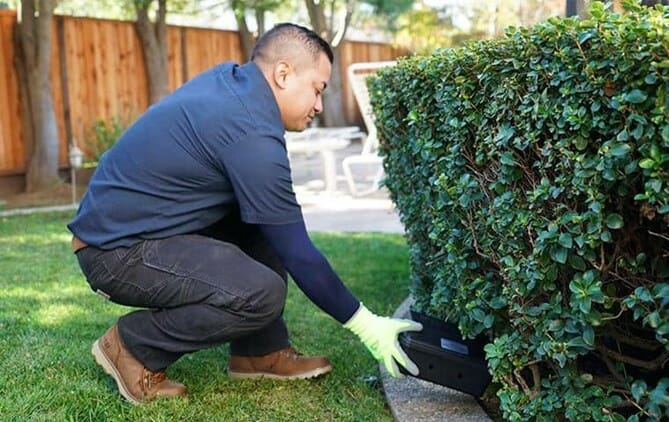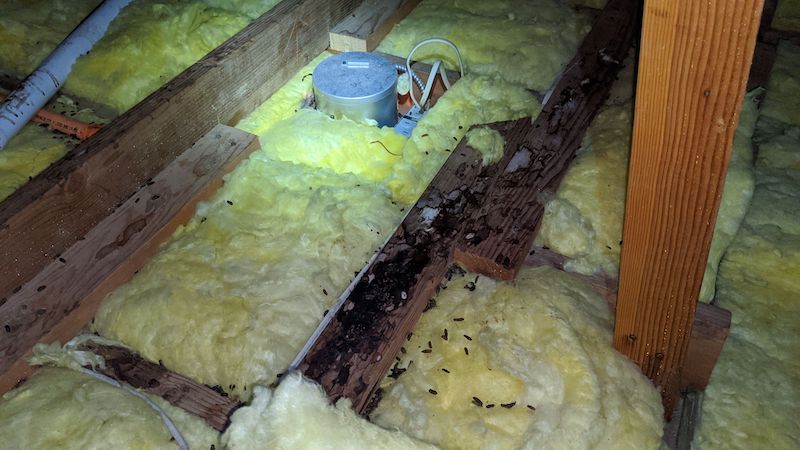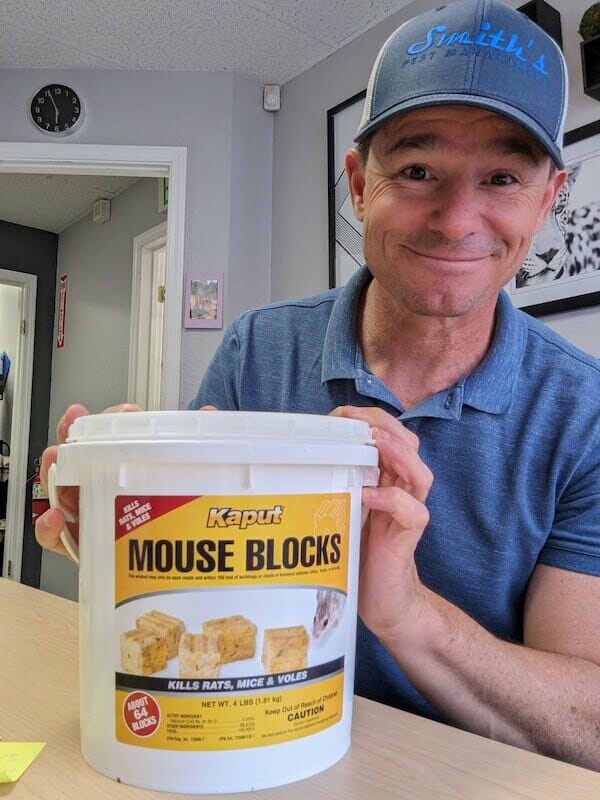In addition to damaging your home, mice carry diseases and can put your family’s health at risk.
At Smith’s, we’ve been helping homeowners in the San Francisco Bay Area address rodent infestations for more than 15 years.
In this post, we share a step by step guide on getting rid of mice from your home – and keeping them out for good.
Key Takeaways
- To get rid of mice, inspect for signs of mouse activity, remove sources of food and shelter, seal the gaps and cracks mice use to enter your home, set mouse traps strategically, and monitor for decreased mouse activity.
- Bait traps with peanut butter or seeds.
- Chemical control methods such as rodenticide baits should be used as a last resort.
- If your DIY methods have failed or your mouse problem is severe, contact a professional pest management company like Smith’s for assistance.
What Attracts Mice?
1. Shelter
In an effort to escape the summer heat or winter cold, mice make their way inside homes, seeking shelter and protection. Thanks to their small bodies, adult mice can fit through spaces as small as ⅜”.
2. Food
Mice need consistent food sources to stay alive. That means they’ll set up shop any place they can find enough food to sustain them.
3. Nesting materials
Mice make nests to birth and rear their babies. They prefer soft materials like shredded paper and cotton but will also use pet hair, insulation, and anything else they can get their paws on.
Important Safety Considerations
Before you get started on DIY mouse control, make sure you’re protecting yourself, your family, and the environment.
Here are the safety steps we recommend:
- Ensure pesticide safety. Keep all rodent baits, traps, and pesticides in a locked cabinet when you’re not using them. Make sure all products are clearly marked and that they’re out of reach of kids and pets.
- Avoid using baits inside. Instead, use traps, exclusion tactics, and repellents to keep mice out of your home.
- If you need to use baits indoors, contain them in tamper-proof bait stations where they’re safe from kids, pets, and non-target species.
- Read and follow all label directions on pesticides, rodenticides, and other toxic products.
- Wear PPE (including goggles, gloves, and long pants) when handling pesticides or baits or disposing of dead mice.
How to Get Rid of Mice in the House
1. Look for Signs of Mouse Activity
While mice are tiny creatures, the clues they leave behind tend to be noticeable.
Identifying where mice are nesting, hiding, and feeding helps you set traps in the correct location and eliminate mouse infestations in walls, ceilings, insulation, and other places faster.
Look for these signs:
- Chew or scratch marks on shelves and around food packaging. You may also notice telltale scratches on baseboards or around floor trim.
- Gnawing damage – mice tend to chew small, clean-cut holes that are about 1.5” in diameter.
- Food crumbs or debris on shelves, in the pantry, or unusual places – like the middle of the floor.
- Mouse droppings, which look like small, oblong pellets. These are common in well-used mouse corridors, under sinks, in the backs of cabinets, or the corners of rooms. Use a flashlight to spot droppings more easily.
- Nests made of fabrics, shredded paper, pet hair, string, or other soft, shredded material.
- Mouse runways, which are smooth, well-worn areas where mice have been traveling.
- Grease marks.
- Dark urine stains.
- Odd pet behavior, such as barking, scratching, or pawing at or under appliances. This may indicate your pets are aware of a pest infestation.
- Sightings of live mice.
- Musty rodent odors, which are usually detectable when large infestations are present.
- Squeaks and scratching sounds. Because mice like to nest in hidden places like wall voids, you may also need to listen for them. Keep an ear out for noises in the walls at night.
2. Remove Food and Shelter
Cleanliness and sanitation are critical to control mouse populations and prevent future re-infestation.
Focus on cleaning up both inside the house and outside to remove their food sources and nesting materials (mice outside the home will eventually become mice inside the house!).
How to do this:
- Store all food (grains, pet food, and other dry goods) in glass or metal containers, which keep food secure since mice cannot chew through them.
- Avoid leaving pet food out for long periods, and promptly clean up all spills and messes.
- Remove soft nesting materials by storing all fabric, rugs, and blankets in heavy-duty plastic storage bins.
- Make your home a less appealing mouse habitat by using a dehumidifier to keep attics, crawl spaces, and basements dry and well-ventilated.
- Make it a rule to only eat at the table – this reduces crumbs and scraps throughout the house and makes it harder for mice to find food within your home.
- Dispose of household recycling quickly (remember that mice will also chew up cardboard, paper, or lightweight plastic to make nests).
- Remove foliage and tree branches within 3 feet of your home’s foundation.
- Keep shrubs, trees, and landscaping plants trimmed back from your foundation and siding.
- Remove rubbish piles, old equipment, rock piles, and rubbish.
- Remove harborage areas indoors, paying particular attention to dark, secluded places like the corners beneath shelves, the area behind cabinets, and the space around appliances.
- Stack wood piles on pallets that keep them at least 18” off the ground, and store them all at least 12 feet away from the walls of your home.
3. Block Mice from Getting in
Mice will try to enter your home in search of food and shelter.
If you block their entry points via what we call “rodent exclusion” they won’t be able to enter your home.
How to do this:
- Seal with caulk tiny holes and gaps greater than ¼” in your foundation, siding, and doorways. Since mice are so small, they can squeeze through tiny gaps as small as ⅜” wide.
- Repair broken basement windows, warped doors, and damaged window screens.
- Keep exterior doors closed tightly, or install a screen door to keep pests out.
- Look for access points into your home, like those created by utility lines or water, electricity, and air conditioning lines – use sheet metal, stainless steel fill fabric, hardware cloth, and mortar to form a mouse-proof barrier.
- Before you bring holiday decorations or last season’s ski clothing out of storage and into the house, inspect all items carefully to ensure mice haven’t nested within them and aren’t hitching a ride inside.
- Install door sweeps on all exterior doors to prevent mice from squeezing through the gaps under doors.
- Place durable, rust-resistant wire screens over vents, chimney openings, and other gaps.
- Replace loose weather stripping around your home’s windows, doors, and basement foundation.
- Deter mice from climbing pipes outside your home by adding guards made of 26-gauge sheet metal and use hard, glossy paint to add a 12” band around the bottom of the vertical pipe.
Pro Tip: Avoid using expandable foam materials from cans (also known as spray foam) since this isn’t an effective long-term solution.
4. Set Mouse Traps
Once you’ve removed food and nesting material and patched the gaps, holes, and cracks mice were using to access your home, it’s time to eliminate your existing mouse population with traps.
How to do this:
- To make your traps as effective as possible, bait them with high-interest foods like peanut butter or seeds and place them in natural rodent runways.
- Use numerous traps set about 6’ apart to increase the chances that mice will encounter them.
- Keep all traps clean and in good working condition, and clean or replace traps after numerous rodent kills since the scent of dead rodents on traps can cause other mice to avoid them.
For an overview on how to trap mice, please see our blog here.
5. Check for Decreased Mouse Activity
Finally, you’ll want to assess the outcomes of your mouse control efforts.
How to do this:
- Look for signs of ongoing mouse activity, including droppings, damage, mouse sightings, mouse smells, or new nesting sites.
- Leave a few traps in high-traffic areas and check them daily for signs of mouse activity.
If your mouse infestation has been resolved, you should shift your efforts on ongoing sanitation. Look out for any new possible mouse entry paths, and seal those immediately.
If you still have lots of mouse activity in your home, it’s best to contact a professional pest control management company that can determine why the infestation isn’t resolving.
What to Use as a Last Resort: Rodenticides
If nothing else works to get rid of your mouse infestation, rodenticides can be effective.
That said, rodenticides should always be used as a last resort, and laypeople should never apply them. These chemicals are highly toxic – some can be fatal – and they pose a real risk to people, pets, and non-target species.
With that in mind, here’s what you need to know about rodenticides:
Rodenticides are a class of pesticides designed to kill rodents: anticoagulants (like warfarin, chlorophacinone, and diphacinone) and non-anticoagulants (such as bromethalin, cholecalciferol, and zinc phosphide).
Rodenticides are available in a variety of formats, including pellet or block baits, loose meal baits, liquid baits, and packet or pouch-style baits. Some rodenticides, like tracking powders, are designed to be ingested while the mice groom themselves, rather than while they’re out foraging for food.
For rodenticides to be as effective as possible, they should always be utilized according to these guidelines:
- The homeowner and pest management professional should remove as many of the mouse’s other food sources as possible, which will make the bait more attractive.
- The rodenticides should be placed in numerous bait stations, all of which contain a small amount of bait, rather than being dispersed into only a few bait stations containing a large amount of bait.
- Bait stations should be placed 8-12 feet apart, depending on the severity of the infestation.
- When possible, place baits directly between mouse harborage areas and their food sources.
- Ensure that bait is always securely placed within enclosed, tamper-proof bait stations specifically designed for use in mouse-baiting programs.
- Label bait stations as “RODENT BAIT – DO NOT TOUCH” and ensure they are inaccessible to children and pets.
- Place baits near exterior openings, where mice enter the home, or near doorways inside of the home.
- Look for signs – such as droppings, shredded paper, and tracks – that indicate mice are favoring a feeding area, and place more baits there.
- Place baits in the corners of rooms, inside of and under cabinets, and under and behind appliances.
- Place baits in warm areas, such as walls near large appliances and underneath stoves, since mice tend to nest in these places.
- Use mouse-size bait stations rather than rat-size bait stations.
- If you notice that mice are not visiting a bait station, move it five feet in another direction to try and intercept mice from different feeding territories.
- Use baits in a three-dimensional fashion: add bait stations to suspended ceilings, and below crawlspaces and floor voids.
- If the mice in your home have developed a food preference and are ignoring your foods or baits, test the efficacy of bait options by placing a few different formulas around your home, and noting which the mice prefer.
- Keep all of your baits fresh – mice won’t consume baits that are stale or moldy.
Pro Tip: When using bait, rodents may die in concealed home areas (e.g., attics, wall voids), leading to unpleasant odors. To avoid this, prioritize exclusion and trapping. After removing all mice from inside your home, initiate outdoor baiting to manage populations and avoid re-infestations.
Methods to Avoid
There are plenty of mouse control methods published on seemingly reputable websites and resources all over the internet.
Unfortunately, there’s no evidence to support the following tactics:
1. Cats
Sure, a cat may kill a few mice, but even the most ferocious mouse hunter won’t be enough to eliminate an established mouse population.
Plus, mice carry diseases and parasites they can easily pass to domestic pets, so encouraging contact between mice and household cats is never a good idea.
2. “Mouse-repellent” plants
Some sources say that strong-smelling plants like garlic, onions, lavender, daffodils, and mint will keep mice from invading your home or garden.
Unfortunately, there’s no evidence to support that claim!
3. Ultrasonic or hazing devices
Ultrasonic or hazing devices (like imitation hawks or motion-activated sprinklers) may startle mice initially, but the rodents will get used to them quickly.
When they do, they’ll keep eating, nesting, and breeding as normal.
4. Cheese for baiting traps
While the cartoons would have us believe that mice love cheese, there are many other foods they prefer, including high-aroma foods like bacon, peanut butter, chicken, and nuts.
If you want your traps to catch mice, don’t waste your time baiting them with cheddar. For best results, pay attention to what mice are eating around your home and use that instead.
5. Fabric Softner
While the strong smell of fabric softener sheets might repel mice at first, it will only take a few days for them to get used to the scent.
What to Expect from a Licensed Pest Control Expert
If your DIY efforts have failed, it may be time to call an exterminator for help.
Here are three steps pest management teams like Smith’s take to get rid of mouse infestations:
1. Initial consultation
Each project starts with a phone consultation and onsite inspection.
During this phase, the team will identify the access points mice are using to get into your home, look for signs of mice, such as droppings and damage, and gauge the severity of the infestation.
2. Action plan
Next, the team will establish a management plan using practical, natural, humane, and holistic methods.
3. Rodent control & exclusion
Finally, the team will deploy the selected rodent control method so you can get life back to normal. Most companies rely heavily on trapping, which contains and removes mice without risking wildlife, pets, and children.
Our professionally-trained staff has years of experience in pest management and is specially equipped to help you navigate pest-control issues with humane, no-kill methods. We also specialize in making your home rodent-proof via our exclusion services.
Need More Help? Turn to Smith’s for Expert Mouse Control
Few things are as frustrating as a mouse infestation. Fortunately, the team here at Smith’s Pest Management can help you identify and deal with mouse problems—reclaiming your space once and for all.
Our team offers various humane and eco-friendly mouse control services to residential and commercial properties in the San Francisco Bay Area including Contra Costa County, San Mateo County, Marin County and all across the Central Coast.
Call today to request a free quote: (408) 871-6988
FAQ
Do mice ever go away?
While getting rid of mice may seem like a never-ending task, it is possible to get them out of your house for good. The trick is to use a combination of methods that are effective for your specific infestation.
For example, trapping mice won’t be enough if you have an active entry point allowing mice into your home. You’ll also need to seal the entry point and eliminate all existing mice.
The fastest and most efficient way to get rid of mice is to hire a professional pest control company like Smith’s. We’ll work with you to identify the source of your infestation and stop it as quickly as possible.
Where do mice hide during the day?
Mice spend most of the day holed up in their nests or shelters.
Most live in cool, dark places like the space between walls, the backs of pantries or cupboards, in attics or crawl spaces, or in clutter like old boxes and stacks of paper.
These areas offer shelter and protection for mice and keep them safe from predators like cats.
How do you know if mice are gone?
The first thing you’ll probably notice is a lack of new mouse droppings. When the mice are gone, the signs and destruction they leave behind will be, too.
After the droppings disappear, you may also notice that you don’t hear the mice any longer or that you’re not cleaning up the debris or nests they leave behind any longer.
What are mice, and what do they look like?
The house mouse is the most common mammal in the world. While they’re native to Central Asia, the mouse came to the Americas on the first European ships to arrive on the mainland. Today, they live in every state across North America.
Adults have small, slender bodies that weigh between 0.5-1 ounce. Their ears are large and almost hairless, while their tails are long, sparsely furred, and covered in scales. The fur is light brown or gray, with white or buff undertones. While mice in captivity live up to two years, wild mice live between 9-18 months.
Mice are highly adaptable and agile. They can jump twelve inches or higher and have excellent senses of smell and touch. While they have poor eyesight, their peripheral vision is adept at detecting movement, making them difficult to catch.
What do mice eat?
Mice eat a varied diet. They prefer cereal, grains, and nuts but will eat whatever is available, including produce and pet food. They have sharp, durable teeth that allow them to chew through plastic packaging and rubber materials. This means they can access even sealed containers.
What diseases do mice carry?
Mice carry a variety of diseases. In fact, they’re responsible for or implicated in the spread of more than 55 diseases that affect both people and domestic animals.
Some of the most common include Hantavirus, the Plague, typhus, rickettsialpox, and bacterial and food-borne illnesses, like salmonella, campylobacter, and rat-bite fever.
What smell will keep mice away?
You can try a variety of natural or commercial repellents including:
- Apple cider vinegar and water. Make a mixture of apple cider vinegar and water. Put it in a spray bottle and spray it around the perimeter of your house, as well as in any indoor access points. Re-apply any natural deterrent you use at least once a month.
- Hot pepper solution. Mix chili flakes, sliced habaneros peppers, dish soap, and water to create a spicy pepper spray that will deter mice. Spray the mixture anywhere you’ve noticed mouse activity. While this mixture is not poisonous to people and pets, it can irritate the eyes, nose, and mouth, so be sure to avoid clothing, furniture, and any place people or pets frequent.
- Commercial repellents. While there is a selection of natural repellents available to deter mice, Smith’s Pest Management also uses professional repellants for severe infestations. We place these repellants strategically to eliminate rodents and help you reclaim your property.
How do I clean up mouse droppings and nests?
After removing the mice from your home, you still need to clean up the mess they’ve left behind.
Here is a six-step guide to safely and effectively clean up after mice:
1. Dress in protective gear
Mouse droppings and nesting materials may harbor dangerous bacteria and pathogens, such as Hantavirus.
Therefore, it is crucial to use protective equipment when cleaning up after rodents. We recommend wearing sturdy rubber or latex gloves, an N95 or HEPA mask (ensure a snug fit for optimal protection), and disposable coveralls to reduce the risk of exposure to hazardous substances.
2. Ventilate the nest area
Prior to cleaning, open any doors and windows in the area for 30-45 minutes. This introduces fresh air into the space and can help clear out airborne pathogens.
3. Soak nest materials in disinfectant
Thoroughly saturate all nesting materials, droppings, and urine patches with a commercial disinfectant or a homemade solution of 1 part bleach to 10 parts water.
Allow the mixture to soak for 5 minutes.
4. Wipe up contaminated materials
Next, use a paper towel or disposable cloth to wipe up the nest materials in the area.
Place the soiled materials in a plastic bag and seal it before disposing of it in an outdoor trash can.
After cleaning, gather all used gloves, coveralls, masks, and cleaning items in a plastic bag. Seal it securely and put it in an outdoor trash bin.
Tip: Avoid sweeping or vacuuming mouse droppings, nesting material, or urine. Sweeping creates airborne particles and can increase the risk of inhalation and cross-contamination.
5. Wash your clothing and hands in hot water
Wash the clothes you wore under your coveralls separately using hot water and a potent detergent. After cleaning, wash your hands and any exposed skin with soap and warm water.
6. Monitor for signs of illnes
After cleaning mouse droppings and nesting materials, monitor yourself for signs of illness. If you experience symptoms such as fever, chills, or muscle aches, contact your healthcare provider promptly.
Should I use chemical mouse baits?
Rodenticide baits are applicable for large infestations when other methods, like trapping, sealing entry points, and removing nest materials, haven’t successfully controlled mouse populations.
Rodenticides are pesticides that are specially formulated to kill rodents.
While rodenticides can be effective, it’s essential to use them safely and to follow all label directions.
See the “rodenticide safety” section below for more on this.
Currently, rodenticides are organized into two broad categories: anticoagulants and non-anticoagulants.
- Anticoagulants. These rodenticides kill mice by disrupting the ability of their blood to clot, which causes them to die of internal bleeding. Common first-generation anticoagulants include warfarin, chlorophacinone, and diphacinone, which are multiple-dose rodenticides, meaning the mouse must eat them several times to consume a lethal dose. If those don’t work, there are also second-generation anticoagulants (designed to kill mice that are resistant to first-generation formulas), such as difethialone and brodifacoum. Most modern anticoagulants are formulated as baits and are available in ready-to-use pellets or blocks.
- Non-anticoagulants. Non-anticoagulant rodenticides rely on ingredients like bromethalin, zinc phosphide, and cholecalciferol. Some non-anticoagulants are single-dose poisons, while others are multiple-dose rodenticides. These rodenticides kill mice in various ways, although none affect the clotting mechanisms of the blood.
Today, most rodenticides are packaged and sold as food bait, which contains a mixture of common grains (such as wheat, oats, and corn) and seed mixtures.
Baits are available in a variety of forms, including blocks, pellets, packets or pouches, and loose meal:
- Block and pellet baits. These are convenient, moisture-resistant baits that are easy for rodents to pick up, handle, and consume. The downside is that they’re also easy for rodents to carry off and horde in wall voids or nests, which can lead to pesticide translocation concerns.
- Loose meal baits. While loose meal baits are less susceptible to pesticide translocation, they tend to absorb moisture from the air, which means you shouldn’t use them in damp or humid areas because they’ll spoil quickly.
- Packet baits. Packet baits seal small amounts of meal or pellet in a plastic, paper, or cellophane package. This renders them ready to use and makes them last longer than other bait formulations. They’re also a great way to visually confirm rodent activity since mice have to chew into the packet to access the bait. Unfortunately, packet baits are also attractive to non-target wildlife, companion animals, and children.
While baits can be an effective form of rodent control, they’re also hazardous. If you live in California and want to use rodent bait stations, be sure you understand California’s laws surrounding the use of rodenticides.
Pros: Effective, fast-acting
Cons: Dangerous, expensive, inhumane, requires application only by a licensed professional, may harm kids, pets, and other wildlife, you must search the house to find dead mice who have consumed the poison, mice may spread or spit out poison in different areas of the home.
Baiting Techniques
- Make baits more attractive for mice by pre-baiting un-set traps or bait stations. Since mice can be wary of bait, pre-baiting (introducing a small amount of new food that doesn’t contain rodenticides) is a great way to encourage mice to take the bait when it does appear. Pre-bait your bait stations or traps for a few days before adding the mouse bait.
- Place bait directly between suspected mouse harborage areas and the mouse’s food source. This ensures the mice will encounter the bait regularly each day.
- Place baits in or near areas that seem to be the mice’s favorite feeding spots.
- Use mouse-sized bait boxes to encourage the mice to feed on your bait.
- Space bait stations 8-12 feet apart, using shorter distances for severe infestations.
- If mice aren’t visiting a bait station, move it 5 feet in any direction to intercept new mouse territories.
- Keep baits fresh – rodents aren’t attracted to old, moldy, or insect-infested bait.
Pro Tip: If you use baits to get rid of mice, you’ll have mice dying in hidden and hard-to-reach areas of the home, like the wall voids. This can cause a really unpleasant smell that lasts for weeks or months. To avoid this, we recommend starting your mouse control efforts with exclusion and trapping – once you’ve gotten rid of all the mice in your home, you can start an outdoor bait program to prevent re-infestation.
Rodenticide Safety Tips
Using rodenticides in urban environments can be dangerous, and it’s critical to take all the necessary safety precautions whenever you DIY mouse control.
Here are a few safety protocols to follow:
- If you’re using bait indoors, always secure it in a tamper-proof bait station and place it out of reach of children, pets, and non-target wildlife.
- Mark all bait stations with “Rodent Bait – DO NOT TOUCH.”
- Never place baits in a location where they can be easily knocked over or bumped.
- Do not insert loose bait blocks or packet-style baits into ceiling or wall voids, where they could be moved by the rodents.
- Store all rodent baits in a secure, locked cabinet that’s out of reach of children and animals.
- Follow all label directions carefully.
- Wear PPE (goggles, gloves, long pants, and shoes) when applying rodent baits.
What type of mouse trap should I use?
Today, there are several different styles of traps on the market. Here’s a brief breakdown of each:
- Snap traps. These traps are widely available and affordable. They can be placed quickly and disposed of or reset easily. They provide a strong snap and instant kill, but they make dead mice highly visible and may present a snap risk for curious kids and pets. We recommend them for controlling small mouse infestations in out-of-the-way areas like attics, crawl spaces, or the space behind cabinets or under appliances.
- Automatic multiple catch traps. There are two basic types of automatic, multiple-catch traps: wind-up-style and low-profile-style traps. Wind-up traps use a spring-loaded platform to flip rodents into a large holding chamber using a spring-loaded platform. Low-profile traps, on the other hand, use a trap door to catch and contain mice. While multiple catch traps are suitable for controlling larger infestations, reusable, and ideal for placing in hard-to-reach areas, they do require the hands-on disposal of mice since the trap doesn’t kill them.
- Glue traps. Glue traps are flat traps coated in a sticky substance. When mice step onto the trap, their feet stick to the surface, and they cannot escape. In addition to being less effective than multiple-catch or snap traps, glue traps are inhumane and must be secured to the floor to be effective. As such, we don’t recommend them as a control method.
- Live traps. Live traps are designed to catch and contain mice until you can release them. While they sound like a nice idea, live traps actually require a lot of extra work and may not even be legal in some places. In California, for example, trapping and relocating wildlife is prohibited.

